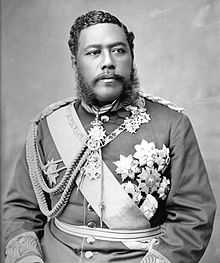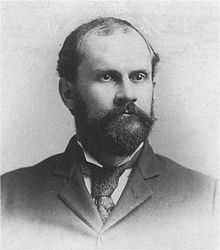1887 Constitution of the Kingdom of Hawaii


| Part of a series on Hawaii |
| Hawaiian sovereignty movement |
|---|
| Main issues |
|
| Governments |
| Historical Conflicts |
|
| Modern Events |
| Parties & Organizations |
| Documents & Ideas |
|
| Books |
|
The 1887 Constitution of the Kingdom of Hawaii was a legal document by anti-monarchists to strip the Hawaiian monarchy of much of its authority, initiating a transfer of power to American, European and native Hawaiian elites. It became known as the Bayonet Constitution for the use of intimidation by the armed militia which forced King Kalākaua to sign it or be deposed.[1][2] The document denied the King most of his personal authority, empowering the legislature and cabinet of the government.These anti-monarchists, known as the Hawaiian League, were mainly white males of American origin, and they quickly appointed themselves as government officials, providing themselves with almost complete control of the government.[3]
Rebellion of 1887
On June 30, 1887 a meeting of residents including the armed militia of the Honolulu Rifles, , a group of white soldiers that were secretly the Hawaiian League’s military arm,[4] and politicians who were members of the Reform Party of the Hawaiian Kingdom demanded King Kalākaua dismiss his cabinet headed by the controversial Walter M. Gibson. The Americans’ concerns for Gibson stemmed from the fact that he supported the King’s authority.[5] The meeting was called to order by Sanford B. Dole,future patriarch of the Dole fruit company, and chaired by Peter Cushman Jones, the president of the largest sugar plantation agency in Hawaii.[6] The Hawaiian League and Americans controlled a vast majority of the Kingdom of Hawaii’s wealth. Lorrin A. Thurston, the main instigator of the subsequent overthrow of the Hawaiian monarchy, prepared a list of demands to the king. The meeting also insisted a new constitution be written.
On the next morning, July 1, 1887, a shipment of arms was discovered from a neutral Australian ship (although later found to be smooth-bore hunting guns used to scare bird from farmers' fields). The Honolulu Rifles took control and arrested and almost hanged Gibson.[7] Kalākaua called in US Minister George W. Merrill, and the British, French, Portuguese and Japanese representatives and requested help. They all suggested he comply with any demands, which he did.[8]:363–364 Thurston then became the powerful interior minister, although Englishman William Lowthian Green was nominally head of the cabinet as minister of finance. Gibson was later exiled to San Francisco.[9]
Over less than a week, the new constitution was drafted by a group of lawyers including Thurston, Dole, William Ansel Kinney, William Owen Smith, George Norton Wilcox, and Edward Griffin Hitchcock. All were also associated with the Hawaiian League, which expressed its purpose of ending the Kingdom and annexation by the United Statessince its inception.[1]
Kalākaua signed the document July 6, 1887, despite arguments over the scope of the changes. It stripped the King of most of his personal authority, empowering the legislature and cabinet of the government. It has since become widely known as the "Bayonet Constitution" because of the threat of force used to gain Kalākaua's cooperation. While Thurston and Dole denied this use of coercion and threats, Queen Liliuokalani asserted that Kalakaua’s life was threatened, and that “He signed that constitution under absolute compulsion.”[10] [1]
Provisions
The 1887 constitution replaced the previous absolute veto allowed to the king to one that two-thirds of the legislature of the Hawaiian Kingdom could override. It took away the power of the king to act without consent of his cabinet, and gave the legislature, which was controlled by the white Americans by this time, the power to dismiss the cabinet instead of the king. It also removed language from the 1864 constitution implying that the king was above the law. The cabinet was now allowed to vote in the legislature, but to reduce the king's influence, he was not allowed to appoint legislators to any other government post. The Legislature also gained the authority to imprison those that disrespected, published false reports or comments about, or threatened or assaulted any member of the Legislature.[11] The constitution also removed the monarch's power to appoint members of the House of Nobles (the upper house of the legislature), instead making it a body elected by the wealthy landowners to six-year terms and enlarging it to 40 members. Qualifications to serve as a Noble or Representative now came to include high property and income requirements as well, which drastically stripped the majority o the native population of the ability to serve in the Legislature. [12] [13]
The 1887 constitution made significant changes to voting requirements. It allowed foreign resident aliens to vote, not just naturalized citizens. Asians, including subjects who previously enjoyed the right to vote, were specifically denied suffrage. Only Hawaiian, American, and European males were granted full voting rights if they met the economic and literacy thresholds.[14]
The 1864 constitution required that voters generate annual income of at least US$75 (equivalent to $1131 in 2015) U.S. dollars, or own private property worth at least US$150 (equivalent to $2262 in 2015). The wealth requirements were removed during the short reign of Lunalilo in 1874.[2] This change extended voter eligibility to many more Hawaiians, and was kept for the lower house of representatives. However, the 1887 constitution required an income of US$600 (equivalent to $15749 in 2015) or taxable property of US$3000 (equivalent to $78744 in 2015) to vote for the upper house (or serve in it). This excluded an estimated two thirds of the Hawaiian population. Essentially, only white males, wealthy from the sugar industry, retained suffrage with the Bayonet Constitution. Allocating the government’s power to the Cabinet, then promptly appointing themselves to the Cabinet, and securing the disenfranchisement of their opposition, the Hawaiian League seized complete control over the Kingdom of Hawaii. The Bayonet Constitution was the first great implement in the downfall of the monarchy.[15]
Native Response
Immediately after the adoption of the Bayonet Constitution, the native population of the Kingdom of Hawaii sought to restore King Kalakaua’s power and authority. A committee of Hawaiians met with Kalakaua to discuss dismantling the constitution because the King signed it under duress. According to Thurston, Kalakaua even defended the constitution to protesting natives, Queen Liliuokalani affirms that he was threatened with violence should he attempt to undo the new constitution. She also lists several petitions from natives that pleaded for a new constitution. Out of 9,500 registered voters, 6,500 signed these petitions. Although the majority of the population constantly begged for a new constitution, when Queen Liliuokalani proposed one in January 1893, the Hawaiian League overthrew her monarchy and took control of the country. [16] [17]
References
- ↑ 1.0 1.1 1.2 David W. Forbes (2003). Hawaiian national bibliography, 1780-1900. University of Hawaii Press. pp. 232–233. ISBN 978-0-8248-2636-9.
- ↑ 2.0 2.1 Anne Feder Lee (June 30, 1993). The Hawaii state constitution: a reference guide. Greenwood Publishing Group. pp. 4–5. ISBN 978-0-313-27950-8.
- ↑ Legge, Charles. "The Hawaiian hijack". Daily Mail. McClatchy-Tribune Information Services via HighBeam Research. Retrieved 5 May 2012. (subscription required)
- ↑ Pat Pitzer. "The Overthrow of the Monarchy." Spirit of Aloha, 1994, 2 Accessed January 27, 2015. http://www,hawaii-nation.org/soa.html.
- ↑ Lorrin A. Thurston, and Andrew Farrell. Memoirs of the Hawaiian Revolution. Honolulu: Advertiser Publishing, 1936. http://catalog.hathitrust.org/Record/001261385.
- ↑ Lorrin A. Thurston, and Andrew Farrell. Memoirs of the Hawaiian Revolution. Honolulu: Advertiser Publishing, 1936. http://catalog.hathitrust.org/Record/001261385.
- ↑ Sanford B. Dole, and Andrew Farrell. Memoirs of the Hawaiian Revolution. Honolulu: Advertiser Publishing, 1936. http://babel.hathitrust.org/cgi/pt?id=uc1.b3477492;view=1up;seq=9.
- ↑ Ralph Simpson Kuykendall (1967). Hawaiian Kingdom 1874-1893, the Kalakaua Dynasty 3. University of Hawaii Press. ISBN 978-0-87022-433-1.
- ↑ "Appointment of a New Cabinet!". Hawaiian Gazette (Honolulu). July 5, 1887. p. 4. Retrieved July 31, 2010.
- ↑ Queen of Hawaii, Liliuokalani. Hawaii's Story by Hawaii's Queen. Boston: Lee and Shepard, 1898, http://digital.library.upenn.edu/women/liliuokalani/hawaii/hawaii.html.
- ↑ Constitution of the Hawaiian Islands, Signed by His Majesty Kalakaua, July 6 and promulgated July 7, 1887. Hawaiian Gazette (Honolulu, HI), 1887. http://hooilina.org/cgi-bin/journal?e=p-0journal--00-0-0-004-Document---0-1--1en-50---20-docoptions-search-issue---001-0110escapewin&a=p&p=frameset&cl=&d=HASH01b8b242efc454f373219e6b.5.1.6
- ↑ Constitution of the Hawaiian Islands, Signed by His Majesty Kalakaua, July 6 and promulgated July 7, 1887. Hawaiian Gazette (Honolulu, HI), 1887. http://hooilina.org/cgi-bin/journal?e=p-0journal--00-0-0-004-Document---0-1--1en-50---20-docoptions-search-issue---001-0110escapewin&a=p&p=frameset&cl=&d=HASH01b8b242efc454f373219e6b.5.1.6
- ↑ Henry Edward Chambers (2009) [January, 1896]. Constitutional History of Hawaii. BiblioBazaar, LLC. pp. 25–27. ISBN 978-1-115-62585-2.
- ↑ Buescher, John. "What Happened to the Royal Family of Hawaii After the U.S. Took Over?" Teachinghistory.org, accessed 1 October 2011.
- ↑ James H Blount, Report of U.S. Special Commissioner James H. Blount to U.S. Secretary of State Walter Q. Gresham Concerning the Hawaiian Kingdom Investigation. Honolulu, HI. July 17, 1893. http://www.hawaiiankingdom.org/blounts-report.shtml.
- ↑ Lorrin A. Thurston, and Andrew Farrell. Memoirs of the Hawaiian Revolution. Honolulu: Advertiser Publishing, 1936. http://catalog.hathitrust.org/Record/001261385.
- ↑ Queen of Hawaii, Liliuokalani. Hawaii's Story by Hawaii's Queen. Boston: Lee and Shepard, 1898, http://digital.library.upenn.edu/women/liliuokalani/hawaii/hawaii.html.
Further reading
- Stephen Kinzer (2006). "A Hell of a Time at the Palace". Overthrow: America's Century of Regime Change from Hawaii to Iraq. Times Books. pp. 9–30. ISBN 978-0-8050-7861-9.
External links
| Wikisource has original text related to this article: |
| ||||||
- 1887 Constitution of the Kingdom of Hawaii (scanned images)
- 1887 Constitution of the Kingdom of Hawaii (Full text, with access to the English translation, and other resources)
Part of a series on the |
|---|
| History of Hawaii |
 |
| Timeline |
| American Hawaii |
| Hawaii portal |
| ||||||||||||||